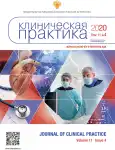The experience with the use of a subacromial balloon in the treatment of patients with large, massive, irreparable rotator cuff tears
- Authors: Lazko М.F.1, Prizov A.P.1, Lazko F.L.1, Beliak E.A.1, Maglaperidze I.G.1, Kyznetsov A.V.1, Akhpashev A.A.1,2
-
Affiliations:
- Peoples’ Friendship University of Russia, Medical Institute
- Academy of Postgraduate Education under the FSBU “Federal Scientific and Clinical Center for Specialized Medical Assistance and Medical Technologies of the Federal Medical Biological Agency”
- Issue: Vol 11, No 4 (2020)
- Pages: 14-22
- Section: Original Study Articles
- URL: https://journals.rcsi.science/clinpractice/article/view/19268
- DOI: https://doi.org/10.17816/clinpract19268
- ID: 19268
Cite item
Full Text
Abstract
Background. Large, massive irreparable rotator cuff tears lead to a significant decrease in the function of the shoulder joint together with the development of a pronounced pain syndrome. Such injuries are difficult to treat, and the number of relapses, when trying to restore them, is quite high. The installation of a subacromial balloon is the method of choice for this group of patients and allows restoring the function of the shoulder joint fairly successfully. Aim: to evaluate the results of the treatment of patients with massive irreparable rotator cuff tears injuries in a prospective study from 2016 to 2018. Methods. The results of the arthroscopic treatment of large, irreparable rotator cuff injuries in 25 patients (with the average age of 67 ± 5 years) with the installation of a subacromial balloon are presented. In all the clinical cases, there was a pronounced (grades 3–4, according to the Goutallier classification) fatty dystrophy of the rotator cuff muscles (supraspinatus or in combination with subaspinatus). All the patients underwent the subacromial space release with a thorough bursectomy and subsequent installation of a subacromial balloon. Results. The average score on the UCLA scale was 14 ± 3 points (11–17) before the operation and 31±2 points (29–33) 12 months after the operation, the results were considered good and excellent. Conclusion. The results obtained allow us to evaluate the described technique as low-traumatic, simple and fast in its accomplishment, aimed at the reduction of the pain syndrome and restoration of the upper extremity function.
Full Text
##article.viewOnOriginalSite##About the authors
Мaksim F. Lazko
Peoples’ Friendship University of Russia, Medical Institute
Author for correspondence.
Email: maxim_lazko@mail.ru
Russian Federation, Moscow
Alexey P. Prizov
Peoples’ Friendship University of Russia, Medical Institute
Email: aprizov@yandex.ru
MD, PhD, docent
Russian Federation, MoscowFedor L. Lazko
Peoples’ Friendship University of Russia, Medical Institute
Email: fedor_lazko@mail.ru
MD, PhD, Professor
Russian Federation, MoscowEvgeny A. Beliak
Peoples’ Friendship University of Russia, Medical Institute
Email: belyakevgen@mail.ru
MD, PhD, assistent
Russian Federation, MoscowIvan G. Maglaperidze
Peoples’ Friendship University of Russia, Medical Institute
Email: v.maglapheridze@mail.ru
MD, PhD, graduate student
Russian Federation, MoscowAleksandr V. Kyznetsov
Peoples’ Friendship University of Russia, Medical Institute
Email: Dr.smith_a@icloud.com
MD, PhD, graduate student
Russian Federation, MoscowAlexander A. Akhpashev
Peoples’ Friendship University of Russia, Medical Institute; Academy of Postgraduate Education under the FSBU “Federal Scientific and Clinical Center for Specialized Medical Assistance and Medical Technologies of the Federal Medical Biological Agency”
Email: akhpashev@gmail.com
MD, PhD, docent
Russian Federation, MoscowReferences
- Bartolozzi A, Andreychik D, Ahmad S. Determinants of outcome in the treatment of rotator cuff disease. Clin Orthop Relat Res. 1994;308:90–97.
- Galatz LM, Ball CM, Teefey SA, et al. The outcome and repair integrity of completely arthroscopically repaired large and massive rotator cuff tears. J Bone Joint Surg Am. 2004;86(2):219–224. doi: 10.2106/00004623-200402000-00002.
- Burkhart SS, Barth JR, Richards DP, et al. Arthroscopic repair of massive rotator cuff tears with stage 3 and 4 fatty degeneration. Arthroscopy. 2007;23(4):347-354. doi: 10.1016/j.arthro.2006.12.012.
- Keener JD, Wei AS, Kim HM, et al. Revision arthroscopic rotator cuff repair: Repair integrity and clinical outcome. J Bone Joint Surg Am. 2010;92(3):590–598. doi: 10.2106/JBJS.I.00267.
- Abouelela AK, Abou Elsoud M. Latissimus dorsi transfer for irreparable rotator cuff tears. Egypt Orthop J. 2014;49(4):330. doi: 10.4103/1110-1148.154097.
- Burkhart SS, Pranckun JJ, Hartzler RU. Superior capsular reconstruction for the operatively irreparable rotator cuff tear: clinical outcomes are maintained 2 years after surgery. Arthroscopy. 2019; 36(2):373–380. doi: 10.1016/j.arthro.2019.08.035.
- Juhan T, Stone M, Jalali O, et al. Irreparable rotator cuff tears: Current treatment options. Orthop Rev (Pavia). 2019;11(3):8146. doi: 10.4081/or.2019.8146.
- Savarese E and Rocco Romeo. New Solution for Massive, Irreparable Rotator Cuff Tears: The Subacromial “Biodegradable Spacer”. Arthroscopy Techniques. 2012; 1(1) : e69-e74.
- Senekovic V, Poberaj B, Kovacic L, et al. The biodegradable spacer as a novel treatment modality for massive rotator cuff tears: a prospective study with 5-year follow-up. Arch Orthop Trauma Surg. 2017;137(1):95–103. doi: 10.1007/s00402-016-2603-9.
- Deranlot J, Herisson O, Nourissat G, et al. Arthroscopic subacromial spacer implantation in patients with massive irreparable rotator cuff tears: clinical and radiographic results of 39 retrospectives cases. Arthroscopy. 2017;33(9):1639–1644. doi: 10.1016/j.arthro.2017.03.029.
- Goutallier D, Postel JM, Bernageau J, et al. Fatty muscle degeneration in cuff ruptures. Pre- and postoperative evaluation by CT scan. Clin Orthop Relat Res. 1994;304:78–83.
- Patte D. Classification of rotator cuff lesions. Clin Orthop Relat Res. 1990;254:81–86.
- Outerbridge RE. The etiology of chondromalacia patellae. 1961. Clin Orthop Relat Res. 2001;(389):5–8. doi: 10.1097/00003086-200108000-00002.
Supplementary files











